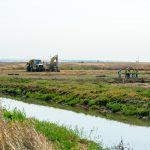Published Date:
September 19, 2016
Tule Red Tidal Wetlands Restoration Project Groundbreaking in Suisun Marsh
 Public-Private Effort to Restore Tides to Hundreds of Acres of Suisun Marsh
Public-Private Effort to Restore Tides to Hundreds of Acres of Suisun Marsh
Tidal Wetlands Help Delta Smelt and Other Imperiled Species
From the California Natural Resources Agency:
Local, state, federal, and private industry leaders on Monday kicked off the largest tidal wetland restoration project in the Delta, breaking ground on a project to return salty tides to several hundred acres for the sake of native fish.
More than a century after people built earthen dikes to block off part of Suisun Marsh to create duck hunting clubs, the Tule Red project in Solano County would open more than 400 acres of wetlands to daily tides. With reworked berms and new channels and basins, the project will create habitat to harbor and boost food production for several threatened or endangered species including the Delta smelt, longfin smelt, and chinook salmon.
Public water districts around California that depend upon the delivery of water from the Delta will pay for the project. Under directives from the U.S. Fish and Wildlife Service and the California Department of Fish and Wildlife, the California Department of Water Resources is obligated to restore 8,000 acres of tidal wetlands in the Sacramento-San Joaquin Delta and 800 acres of tidal wetlands in or around the Suisun Marsh. The Department of Water Resources (DWR) owns and operates the State Water Project.
The Tule Red project also advances the California EcoRestore program, which seeks to get at least 30,000 acres of habitat restoration underway in the Delta before Governor Edmund G. Brown Jr. leaves office in 2018.
“Human intervention altered the Delta profoundly over the last 150 years, and with projects like Tule Red, we can intervene to turn back the clock,” said California Natural Resources Secretary John Laird. “When we welcome tides back to a few hundred acres of Suisun Marsh, we reverse the trends that eliminated 95 percent of the tidal wetlands in the Bay-Delta, the largest estuary in the Western Hemisphere.”
The Tule Red project also advances the state’s Delta Smelt Resiliency Strategy, released in July 2016 to guide immediate and near-term actions to improve the survival and reproduction of the threatened fish species endemic to the Delta.
“The gradual loss of tidal marshes in the estuary has resulted in a reduction of habitat for many imperiled species,” said Paul Souza, regional director of the U.S. Fish and Wildlife Service’s Pacific Southwest Region. “Restoring tidal wetlands should help improve habitat conditions for Delta smelt and their food supply, while providing suitable habitat to other species.”
The Tule Red Restoration Project is a joint effort by the State and Federal Contractors Water Agency (SFCWA) and DWR. SFCWA is a joint powers authority comprised of the public water agencies that contract for delivery of water from the State Water Project and the Central Valley Project. SFCWA is pursuing Tule Red and other habitat restoration projects to assist DWR with meeting existing permit requirements under the U.S. Endangered Species Act.
Under an agreement with SFCWA, Westervelt Ecological Services has provided the restoration design and will oversee the construction contractor, Great Lakes Environmental and Infrastructure, LLC. After construction, plans are to turn the project over to the California Department of Fish and Wildlife, which will own and manage it with State Water Project funding from DWR.
Construction on the Tule Red project will begin in 2016 and is expected to be completed in 2019.
“As stewards of our public water supplies, the agencies that form the State and Federal Contractors Water Agency are pleased to be on the front lines of restoring the Bay-Delta ecosystem and we look forward to developing additional projects that benefit native species,” said Jason Peltier, Chairperson of SFCWA.
Commonly known as the Tule Red Hunting Club, the 420-acre duck club is located along Grizzly Bay in Suisun Marsh. Before it was diked to create fresh and brackish water habitat favored by game ducks in the early 1900′s, this property was tidal habitat, with seasonal fresh water inundation during wet winter periods. The Suisun Marsh, south of Fairfield, is the largest contiguous brackish water marsh on the west coast of North America. The 116,000-acre marsh represents more than 10 percent of the remaining natural wetlands area in the state.
The Tule Red project will involve breaching a natural berm to allow for full daily tidal exchange through the interior of the project site and creation of a network of channels to convey water across the marsh plain. The project is designed to not only provide habitat to Delta smelt, longfin smelt, salmonids, and other native fishes, but also to reestablish important ecological processes that will maximize production of the microscopic plants and animals at the base of the food web that nourish native fish. One of the factors that has led to the precipitous decline of Delta smelt and other native species is lack of food resources.
More information about the project is available here.
To learn more about California EcoRestore and other habitat restoration projects underway in the Delta, go to http://resources.ca.gov/ecorestore/.


